Forgotten Realms is a campaign setting for the Dungeons & Dragons (D&D) fantasy role-playing game. Commonly referred to by players and game designers as "The Realms", it was created by game designer Ed Greenwood around 1967 as a setting for his childhood stories. Several years later, it was published for the D&D game as a series of magazine articles, and the first Realms game products were released in 1987. Role-playing game products have been produced for the setting ever since, in addition to novels, role-playing video game adaptations, comic books, and the film Dungeons & Dragons: Honor Among Thieves.

Pool of Radiance is a role-playing video game developed and published by Strategic Simulations, Inc (SSI) in 1988. It was the first adaptation of TSR's Advanced Dungeons & Dragons (AD&D) fantasy role-playing game for home computers, becoming the first episode in a four-part series of D&D computer adventure games. The other games in the "Gold Box" series used the game engine pioneered in Pool of Radiance, as did later D&D titles such as the Neverwinter Nights online game. Pool of Radiance takes place in the Forgotten Realms fantasy setting, with the action centered in and around the port city of Phlan.

Ed Greenwood is a Canadian fantasy writer and the original creator of the Forgotten Realms game world. He began writing articles about the Forgotten Realms for Dragon magazine beginning in 1979, and subsequently sold the rights to the setting to TSR, the creators of the Dungeons & Dragons roleplaying game, in 1986. He has written many Forgotten Realms novels, as well as numerous articles and D&D game supplement books.

Icewind Dale is a role-playing video game developed by Black Isle Studios and originally published by Interplay Entertainment for Windows in 2000 and by MacPlay for the Macintosh in 2002. The game takes place in the Dungeons & Dragons Forgotten Realms campaign setting and the region of Icewind Dale, and uses the 2nd edition ruleset. The story follows a different set of events than those of R. A. Salvatore's The Icewind Dale Trilogy novels: in the game, an adventuring party becomes enlisted as a caravan guard while in Icewind Dale, in the wake of strange events, and eventually discover a plot that threatens the Ten Towns of Icewind Dale and beyond.

Dark Age of Camelot is a massively multiplayer online role-playing game released in October 2001 in North America, and in January 2002 in Europe. The game combines Arthurian lore, Norse mythology, and Irish Celtic legends with high fantasy. It is set in the period after King Arthur's death, when his kingdom has split into three realms, which are in a constant state of war with each other. Dark Age of Camelot includes both player versus environment (PvE) and realm versus realm (RvR) combat.

Curse of the Azure Bonds is a role-playing video game developed and published by Strategic Simulations, Inc (SSI) in 1989. It is the second in a four-part series of Forgotten Realms Advanced Dungeons & Dragons Gold Box adventure computer games, continuing the events after the first part, Pool of Radiance.

Gold Box is a series of role-playing video games produced by SSI from 1988 to 1992. The company acquired a license to produce games based on the Advanced Dungeons & Dragons role-playing game from TSR, Inc. These games shared a common game engine that came to be known as the "Gold Box Engine" after the gold-colored boxes in which most games of the series were sold.
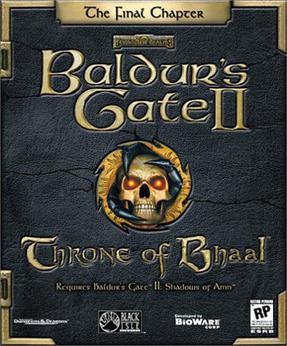
Baldur's Gate II: Throne of Bhaal is a 2001 expansion pack for the role-playing video game Baldur's Gate II: Shadows of Amn. It adds a multi-level dungeon called Watcher's Keep to the game and completes the main plot. There are several new weapons, a higher level cap, a further refined Infinity graphics engine, and new class-related features and magical skills. The novelization of the game was written by Drew Karpyshyn and released in September 2001.
Mystra is a fictional goddess in the Forgotten Realms campaign setting for the Dungeons & Dragons fantasy role-playing game.
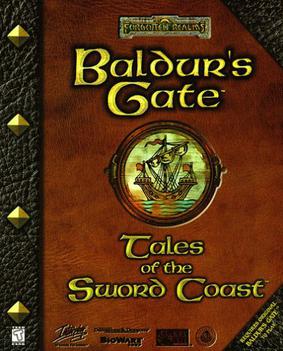
Baldur's Gate: Tales of the Sword Coast is an expansion pack of the fantasy role-playing video game Baldur's Gate. Developed by BioWare and published by Interplay, it adds 20 to 30 extra hours of gameplay, including the addition of four areas and minor tweaks to some of the mechanics. The expansion consists of four notable quests that take place within the same game world as Baldur's Gate, and sees players taking their character and their party of companions across the Sword Coast, from travelling to a distant island, to exploring the fortress dungeon of a dead dwarf. Tales of the Sword Coast sold 600,000 units by 2003.

Baldur's Gate II: Shadows of Amn is a role-playing video game developed by BioWare and published by Interplay Entertainment. It is the sequel to 1998's Baldur's Gate and was released for Microsoft Windows in September 2000. Following its predecessor, the game takes place in the Forgotten Realms, a fantasy campaign setting, and is based on the Advanced Dungeons & Dragons 2nd edition rules. Powered by BioWare's Infinity Engine, Baldur's Gate II uses an isometric perspective and pausable real-time gameplay. The player controls a party of up to six characters, one of whom is the player-created protagonist; the others are certain characters recruited from the game world.

Minsc is a fictional character in the Baldur's Gate series of Dungeons & Dragons role-playing video games developed by BioWare and Larian Studios. He originated from the pen-and-paper Dungeons & Dragons sessions held by the lead designer of Baldur's Gate, James Ohlen, and was expanded upon by the game's lead writer, Lukas Kristjanson. His video game debut was in Baldur's Gate as a companion character who can join the player's party. He also appears in the sequel, Baldur's Gate II: Shadows of Amn, the expansion, Baldur's Gate II: Throne of Bhaal, the 2015 game Baldur's Gate: Siege of Dragonspear, the 2023 game Baldur's Gate 3, as well as in promotions relating to the titles. Minsc is voiced by Jim Cummings in his original video game appearances, and by Matt Mercer in Baldur's Gate 3.
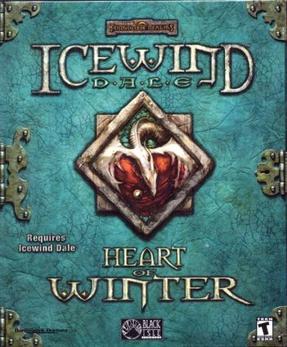
Icewind Dale: Heart of Winter is a 2001 expansion pack to the role-playing video game Icewind Dale, developed by Black Isle Studios and published by Interplay Entertainment. It introduced many changes and additions to the original game, and included a new campaign. A downloadable add-on to this expansion pack, titled Trials of the Luremaster, was released for free. Both the expansion and add-on were included in Icewind Dale: Enhanced Edition.

Baldur's Gate is a role-playing video game that was developed by BioWare and published in 1998 by Interplay Entertainment. It is the first game in the Baldur's Gate series and takes place in the Forgotten Realms, a high fantasy campaign setting, using a modified version of the Advanced Dungeons & Dragons (AD&D) 2nd edition rules. It was the first game to use the Infinity Engine for its graphics, with Interplay using the engine for other Forgotten Realms-licensed games, including the Icewind Dale series and Planescape: Torment. The game's story focuses on a player-made character who travels across the Sword Coast alongside a party of companions.
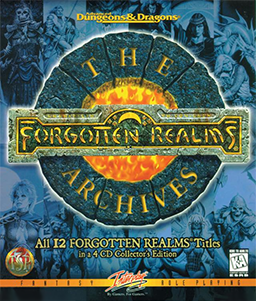
The Forgotten Realms Archives is a compilation of the AD&DForgotten Realms series from the beginning of the series in 1988 through 1994, including 12 complete games. It was released in April 1997, and re-released a year later as a Silver Edition, which included an interactive demo for 1998's Baldur's Gate, and republished in 2001 as part of the Gamefest Interplay collector's series, Gamefest: Forgotten Realms Classics.

Diablo II: Lord of Destruction is an expansion pack for the hack and slash action role-playing game Diablo II. Unlike the original Diablo's expansion pack, Diablo: Hellfire, it is a first-party expansion developed by Blizzard North.
Pool of Radiance is a series of role-playing video games set in the Forgotten Realms campaign settings of Dungeons & Dragons; it was the first Dungeons & Dragons video game series to be based on the Advanced Dungeons & Dragons rules.
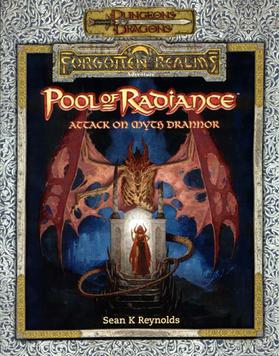
Pool of Radiance: Attack on Myth Drannor is an adventure module for the 3rd edition of the Dungeons & Dragons fantasy role-playing game.
Carrie A. Bebris is an American author, journalist and novelist.















